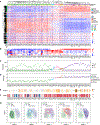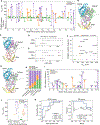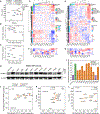Interface-guided phenotyping of coding variants in the transcription factor RUNX1
- PMID: 38968069
- PMCID: PMC11345852
- DOI: 10.1016/j.celrep.2024.114436
Interface-guided phenotyping of coding variants in the transcription factor RUNX1
Abstract
Single-gene missense mutations remain challenging to interpret. Here, we deploy scalable functional screening by sequencing (SEUSS), a Perturb-seq method, to generate mutations at protein interfaces of RUNX1 and quantify their effect on activities of downstream cellular programs. We evaluate single-cell RNA profiles of 115 mutations in myelogenous leukemia cells and categorize them into three functionally distinct groups, wild-type (WT)-like, loss-of-function (LoF)-like, and hypomorphic, that we validate in orthogonal assays. LoF-like variants dominate the DNA-binding site and are recurrent in cancer; however, recurrence alone does not predict functional impact. Hypomorphic variants share characteristics with LoF-like but favor protein interactions, promoting gene expression indicative of nerve growth factor (NGF) response and cytokine recruitment of neutrophils. Accessible DNA near differentially expressed genes frequently contains RUNX1-binding motifs. Finally, we reclassify 16 variants of uncertain significance and train a classifier to predict 103 more. Our work demonstrates the potential of targeting protein interactions to better define the landscape of phenotypes reachable by missense mutations.
Keywords: CP: Genomics; CP: Molecular biology; Perturb-seq; RNA-seq; cancer; coding variant; interface; protein-protein interaction; single-cell; transcription factor.
Copyright © 2024 The Author(s). Published by Elsevier Inc. All rights reserved.
Conflict of interest statement
Declaration of interests P.M. is a scientific co-founder of Shape Therapeutics, Navega Therapeutics, Boundless Biosciences, and Engine Biosciences. The terms of these arrangements have been reviewed and approved by the University of California, San Diego in accordance with its conflict-of-interest policies.
Figures






Update of
-
Interface-guided phenotyping of coding variants in the transcription factor RUNX1 with SEUSS.bioRxiv [Preprint]. 2023 Aug 4:2023.08.03.551876. doi: 10.1101/2023.08.03.551876. bioRxiv. 2023. Update in: Cell Rep. 2024 Jul 23;43(7):114436. doi: 10.1016/j.celrep.2024.114436. PMID: 37577681 Free PMC article. Updated. Preprint.
Similar articles
-
Interface-guided phenotyping of coding variants in the transcription factor RUNX1 with SEUSS.bioRxiv [Preprint]. 2023 Aug 4:2023.08.03.551876. doi: 10.1101/2023.08.03.551876. bioRxiv. 2023. Update in: Cell Rep. 2024 Jul 23;43(7):114436. doi: 10.1016/j.celrep.2024.114436. PMID: 37577681 Free PMC article. Updated. Preprint.
-
Potential molecular mechanisms of ETV6-RUNX1-positive B progenitor cell cluster in acute lymphoblastic leukemia revealed by single-cell RNA sequencing.PeerJ. 2024 Nov 1;12:e18445. doi: 10.7717/peerj.18445. eCollection 2024. PeerJ. 2024. PMID: 39498293 Free PMC article.
-
RUNX1 mutations in blast-phase chronic myeloid leukemia associate with distinct phenotypes, transcriptional profiles, and drug responses.Leukemia. 2021 Apr;35(4):1087-1099. doi: 10.1038/s41375-020-01011-5. Epub 2020 Aug 11. Leukemia. 2021. PMID: 32782381 Free PMC article.
-
RUNX1 and CBFβ Mutations and Activities of Their Wild-Type Alleles in AML.Adv Exp Med Biol. 2017;962:265-282. doi: 10.1007/978-981-10-3233-2_17. Adv Exp Med Biol. 2017. PMID: 28299663 Review.
-
Molecular targeting of aberrant transcription factors in leukemia: strategies for RUNX1/ETO.Curr Drug Targets. 2010 Sep;11(9):1181-91. doi: 10.2174/138945010792006744. Curr Drug Targets. 2010. PMID: 20583973 Review.
Cited by
-
Multiplexed assays of variant effect for clinical variant interpretation.Nat Rev Genet. 2025 Jul 21. doi: 10.1038/s41576-025-00870-x. Online ahead of print. Nat Rev Genet. 2025. PMID: 40691352 Review.
References
-
- Roock WD, De Roock W, Jonker DJ, Di Nicolantonio F, Sartore-Bianchi A, Tu D, Siena S, Lamba S, Arena S, Frattini M, et al. (2010). Association of KRAS p.G13D Mutation With Outcome in Patients With Chemotherapy-Refractory Metastatic Colorectal Cancer Treated With Cetuximab. JAMA 304, 1812–1820. 10.1001/jama.2010.1535. - DOI - PubMed
MeSH terms
Substances
Grants and funding
LinkOut - more resources
Full Text Sources
Research Materials
Miscellaneous

